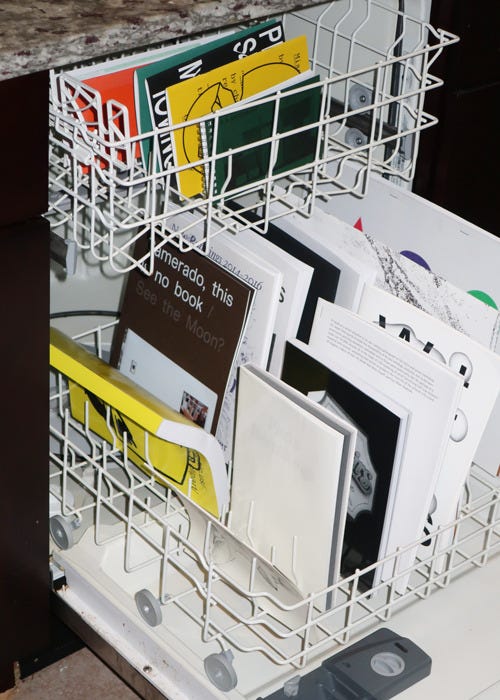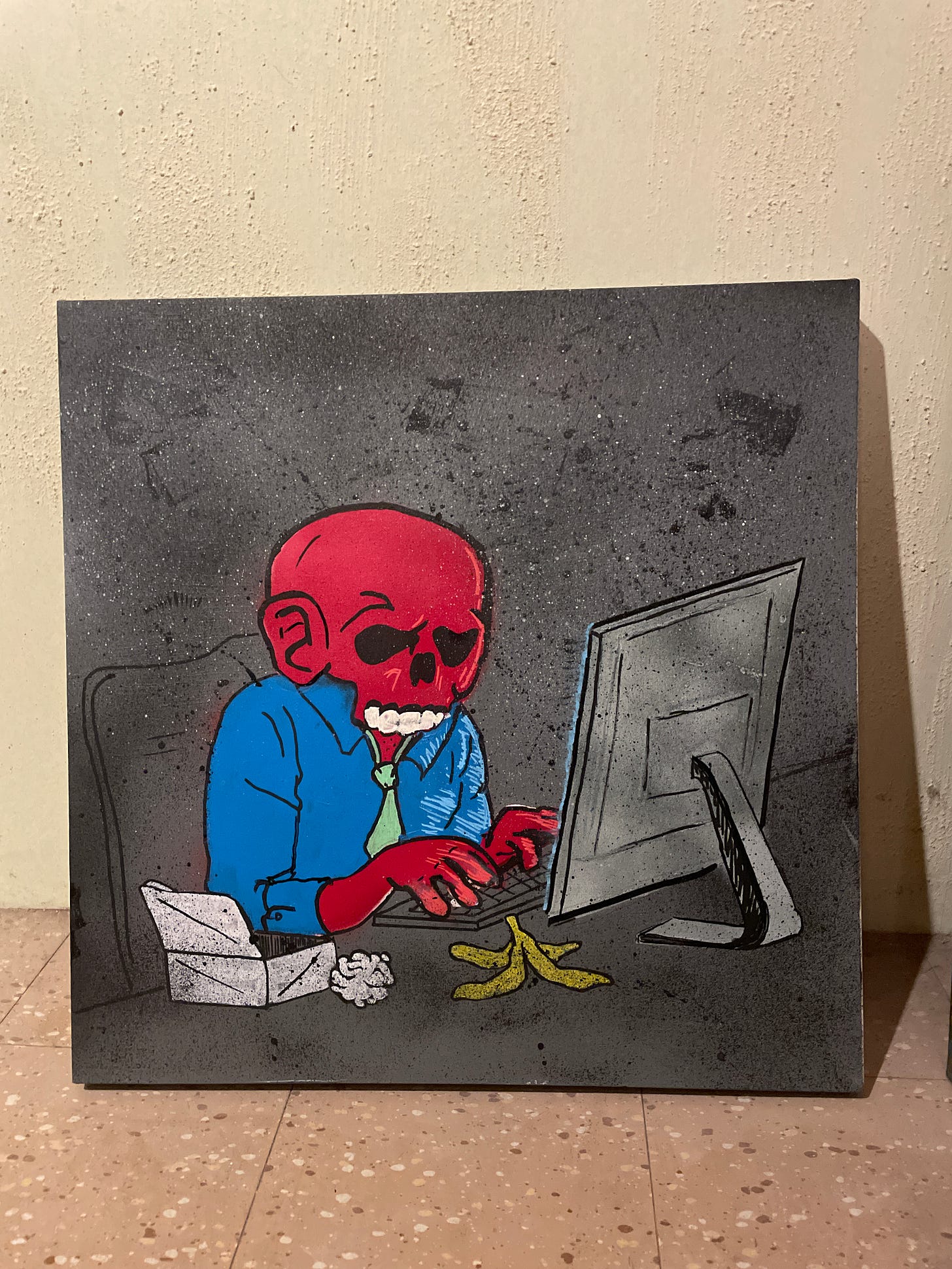This week is gonna be heavy on the words.
Office Culture;
Among all the conversation about going back to the office, there is one thing I think people forget. We are a creative industry. If you work at a creative agency, creativity is part of your offering. This goes for everyone. Not just the creative team.
Creativity is the result of people with resources to play.
This could involve a speaker or two, but it is simpler than that.
This isn’t a playbook or an opinion article ready to be published in AdAge… This is text copy/pasted from a notes doc I typed after visiting our LA office.
How to get people back to the office:
An office people want to be in encourages people to mess around. To feel like the office is a place they have some part in.
This might mean googly eyes and mustaches appear on faces of artwork around the office.
It could be a 6’ tall foam core display board dedicated to non work related nonsense. All laminated by someone’s laminator they brought in for fun.
It might mean hiding miniature plastic dinosaurs in conference rooms or taping artwork descriptions above the urinals.
As far as things mgmt can do?
Stash poorly hidden $100 bills every now and then. Make it clear finders are indeed keepers.
Have a professional portrait painter come in and do neoclassical portraits. Or a tattoo artist. Or puppies.
Let people design swag without being precious. Let your design team go nuts. Make things non employees would buy. Sell them.
Offer free sketch books, pens, paint, paper, etc.
Offer resources, that are typically barriers to people who make art for fun. (nice printer, CNC machine, encouraging guests, access passes to artist friends)
Stipends for experimenting and creating. Less about content pillars or incentives more about enabling curiosity and play. Don’t ask, but reward.
Thought leadership should be a showcase of employees. Act like a publisher– a platform for people’s side projects. Keep loose editorial guidelines and give resources to pursue things without requiring people to jump thru hoops.
Open an employee shop. Sell the branded merch they make. And their own art.
Your goal should be to create a public space that attracts people from other agencies. Coffee shop, maker space, bar, library, etc.
Less desks. More space. Quiet space. Social space. Collaboration space. Workshop, screening room, studio, rotating vendor of non perishable goods at discount. space that engages, rather than stifles.
Lockers. Access on weekends. Trust. Things that benefit the people who work there, rather than simply the production of the work.
found on Reddit: A really good breakdown of a Planner’s role
Emphasis mine.
As a creative/CD, I don't view a strategist as a leader, that puts you on the wrong footing and gives you a very different and IMO, wrong approach in the work and how you work.
u/Toucan_Lips hit the points.
The good strategists I worked with are partners. They know a plan seldom survives first contact, and first contact to me is when creatives get hold of your precious strat or brief. The good ones I worked with can flex and adapt the way creatives have to flex and adapt. They can look at ideas and help tie them back to the strat or business challenge, and figure out how to position the ideas to sell them.
The worst strategists I worked with, for which there are many, are empty vessels who think they command the room because of their title (and most ECDs and CCOs don't even do that), who pretend to hear but doesn't listen—repeat themselves condescendingly as though that will change people's minds, won't take onboard other opinions or feedback, think they're know it all and the be all and end all. And in some instances, actually conflate their roles with the CDs.
And also pointed out, most strategists simply don't put enough thinking into the strat. It's all boiler plate. And I'm not afraid to make this contentious comparison—there is a lot of interrogation and rigor applied to creative thinking and ideas. As a creative, I'm half strat too—I take the brief, come up with the ideas, ensure they're strategically on-point, or come at the business challenge in a different way, and I know the industry standards I need to hit or crack—Cannes, One Show, pick the poison.
But when it comes to strat, it feels like it goes through one round of review—which I know isn't true—and sometimes a month is wasted ruminating or whatever's being done—with very little filtering or attempt at breaking through to new grounds, before it ends up in a brief for creatives to ideate against.
So if you're asking how to be a good strategist, think hard at it. Surfacing trends isn't enough, any creative can do that homework. Do the competitive analysis, look at the landscape, the trends, find an approach at those intersections (because a good seasoned creative do that too and it's the strat's role to pre-empt and make it easier for creatives to go off on a running start—you're doing the pre-game) that tells me something like Avis' We overcompensate because we're second, Snicker's You're not yourself when you're running on empty. Not some generic cliches like, Let's celebrate blah, We want to empower blah.
And from the briefs I see, most strat seem to think doing the work needs to come through in how complicated it is, as though a simple strat will make the strategist look bad; when it's your job to pare it down with clarity and focus just like it's our job to come up with ideas that are simple but detonate on impact.
A strat's role is to bridge creative with the business, and ultimately to stage the ideas/work to sell them in.
Not to get into a pissing contest with creatives for some misguided alpha posturing.
SHOW THAT IT’S PRETTY EVEN WHEN IT’S UGLY.
We don’t think like this enough; Fockups is a mockup template pack that lets you put your mocks into more realistic scenarios.
We are encouraged to say orca rather than killer whale… but orca means “whale from hell”
I’m not sure how this is relevant to advertising but somehow I’m sure that it is
A thought / possibly something I heard somewhere and wrote down:
Consuming puts you to work for the internet, creating puts the internet to work for you.
On a related note that I’m almost positive I’ve included before:
We are surrounded by worn-out, banal, useless and exhausted images, limping and dragging themselves behind the rest of our cultural evolution.
Werner Herzog
Lastly (other than monsters), I’m going to be giving a talk and leading a workshop session for the Sweathead Strategy Do Together.
It always makes me pause and feel something when I see my name next to people who have inspired me as a planner.
So, if you’re on the fence– my talk will be fun. But with people like Lexie, Rachel, Derek, Vanessa, Tom, Shann, Vikki, Richard, etc.. I can promise it’ll be valuable as well.
WEEKLY MONSTERS
I painted a self portrait.










